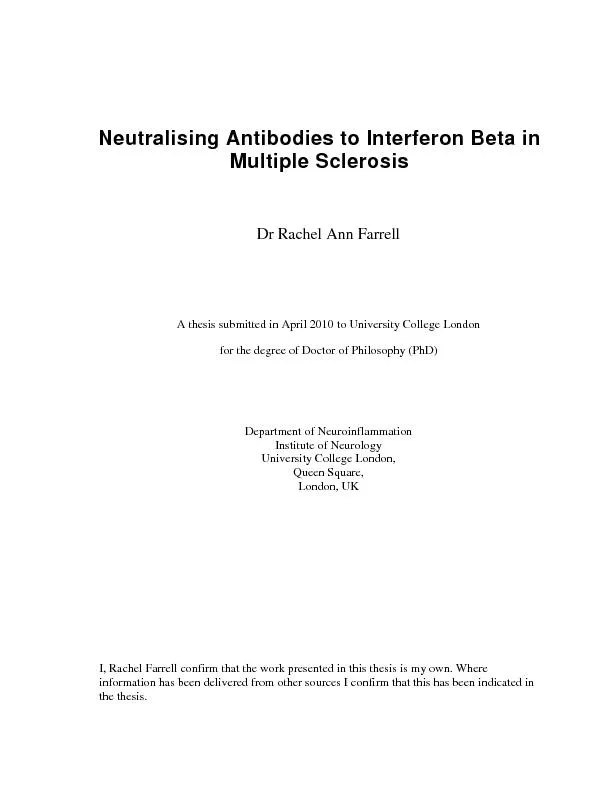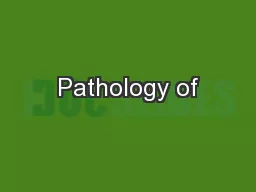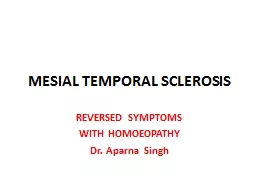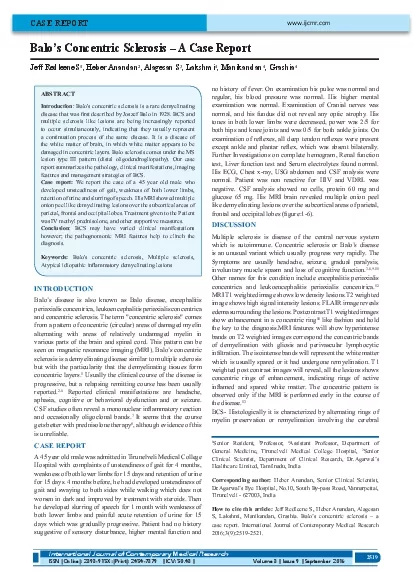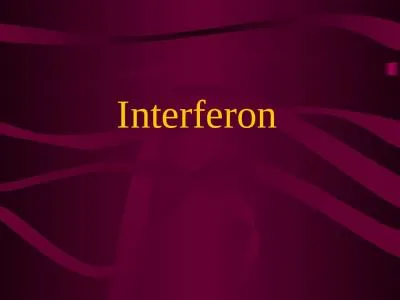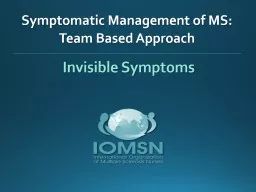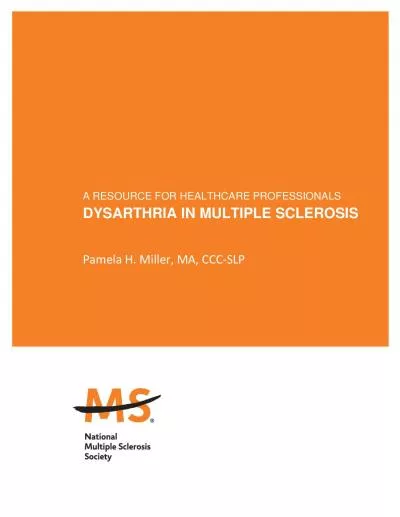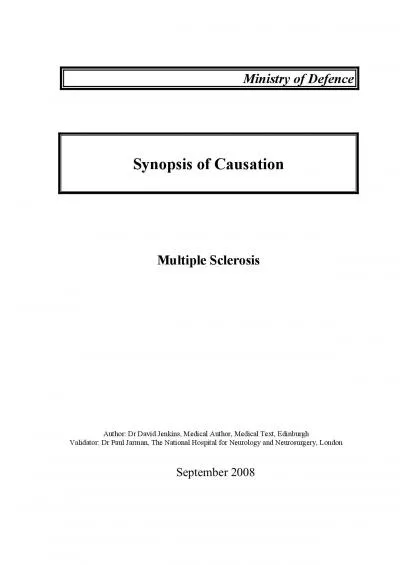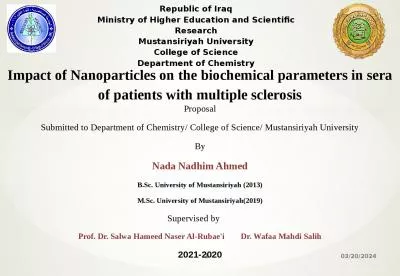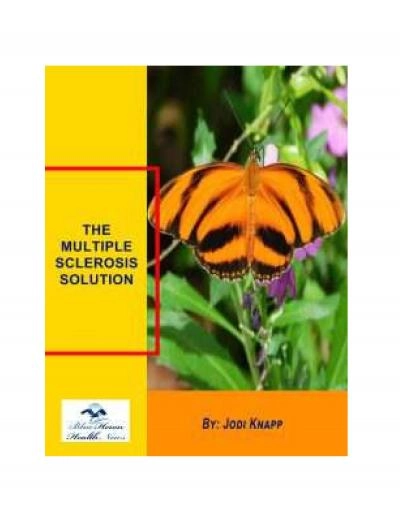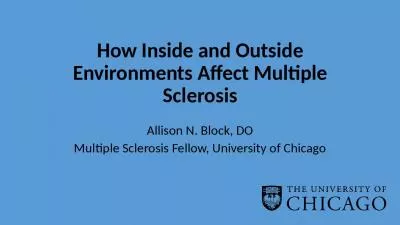PDF-Neutralising Antibodies to Interferon Beta in Multiple Sclerosis Dr Ra
Author : liane-varnes | Published Date : 2016-06-30
Abstract Multiple Sclerosis is the most common nontraumatic cause of neurological disability in young people Until recently few treatments existed for Multiple Sclerosis
Presentation Embed Code
Download Presentation
Download Presentation The PPT/PDF document "Neutralising Antibodies to Interferon Be..." is the property of its rightful owner. Permission is granted to download and print the materials on this website for personal, non-commercial use only, and to display it on your personal computer provided you do not modify the materials and that you retain all copyright notices contained in the materials. By downloading content from our website, you accept the terms of this agreement.
Neutralising Antibodies to Interferon Beta in Multiple Sclerosis Dr Ra: Transcript
Abstract Multiple Sclerosis is the most common nontraumatic cause of neurological disability in young people Until recently few treatments existed for Multiple Sclerosis and Interferon beta was the. Introduction of Case Study. In this case the person is multiple Sclerosis patient. She is about 34 years of age.. Patient feels that her left body portion is relatively weak, massive fatigue with a potential . Demyelinating. disease. Thomas Shoemaker, MD PGY-3. Department of Neurology. October 27. th. , 2014. School of Arts of and Sciences. Department (Click here to edit). Question #1. The hallmark of an active . REVERSED SYMPTOMS. WITH HOMOEOPATHY . Dr.. . Aparna. Singh. LEFT MTS where the arrow points at the lesion. ATROPHY AND GLIOSIS OF THE NEURONAL CELLS. 17/07/2014. WAS PUT ON ANTI-EPILEPTIC DRUGS, EVEN WHEN THERE WERE NO SEIZURES- Max . 2519Jeff Redleene S1 Heber Anandan2 Alagesan S3 Lakshmi4 Manikandan4 Grashia4CASE REPORTIntroduction Balos concentric sclerosis is a rare demyelinating disease that was x00660069rst described by Josze 1957. Isaacs and . Lindenmann. . Did an experiment using chicken cell cultures. Found a substance that interfered with viral replication and was therefore named interferon. What are . Interferons. ?. MS: . Team Based Approach. Multi-Disciplinary Team Approach. Primary Care . Physician. Neurologist. Nurse/NP. Occupational Therapist. Physical Therapist. Social Worker. Psychologist/. Neuropsychologist. DYSARTHRIA IN M ULTIPLE S CLEROSIS Pamela H. Miller, MA, CCC - SLP National MS Society | Dysarthria in Multiple Sclerosis 1 The National MS Society’s Professional Resource Center provides: • 141 Focal Hand Dystonia as a Sign of Demyelinating Attack in Multiple Movement disorders are rarely seen in multiple sclerosis (MS). of attack is controversial and it depends on certain conditions. I 870 Cortical neuronal densities and cerebral white matter demyelination in multiple sclerosis: a retrospective studyBruce D Trapp, Megan Vignos, Jessica Dudman, Ansi Chang, Elizabeth Fisher, Susan M S This synopsis has been completed by medical practitioners. It is based on a literature search at the standard of a textbook of medicine and generalist review articles. It is not intended to be a meta- Republic of Iraq. Ministry of Higher Education and Scientific Research. Mustansiriyah. University. College of Science. Department of Chemistry. Proposal. Submitted to Department of Chemistry/ College of Science/ . Jodi Knapp: The Multiple Sclerosis Solution PDF, The Multiple Sclerosis Solution Free Download, The Multiple Sclerosis Solution eBook, The Multiple Sclerosis Solution Reviews, The Multiple Sclerosis Solution Exercises, The Multiple Sclerosis Solution Reddit, Buy The Multiple Sclerosis Solution Discount, The Multiple Sclerosis Solution Remedies, The Multiple Sclerosis Solution Blue Heron Health News. Download PDF Natural Multiple Sclerosis Treatment System™ eBook by Dr. Gary M. Levin - a natural, holistic approach to improve and manage multiple sclerosis through specialized nutrition and vitamin supplementation. Allison N. Block, DO. Multiple Sclerosis Fellow, University of Chicago. Outline. I. Inside environment. Gut microbiome. Epstein-Barr virus . II. Outside environment. Obesity. Tobacco use. Vitamin D.
Download Document
Here is the link to download the presentation.
"Neutralising Antibodies to Interferon Beta in Multiple Sclerosis Dr Ra"The content belongs to its owner. You may download and print it for personal use, without modification, and keep all copyright notices. By downloading, you agree to these terms.
Related Documents

